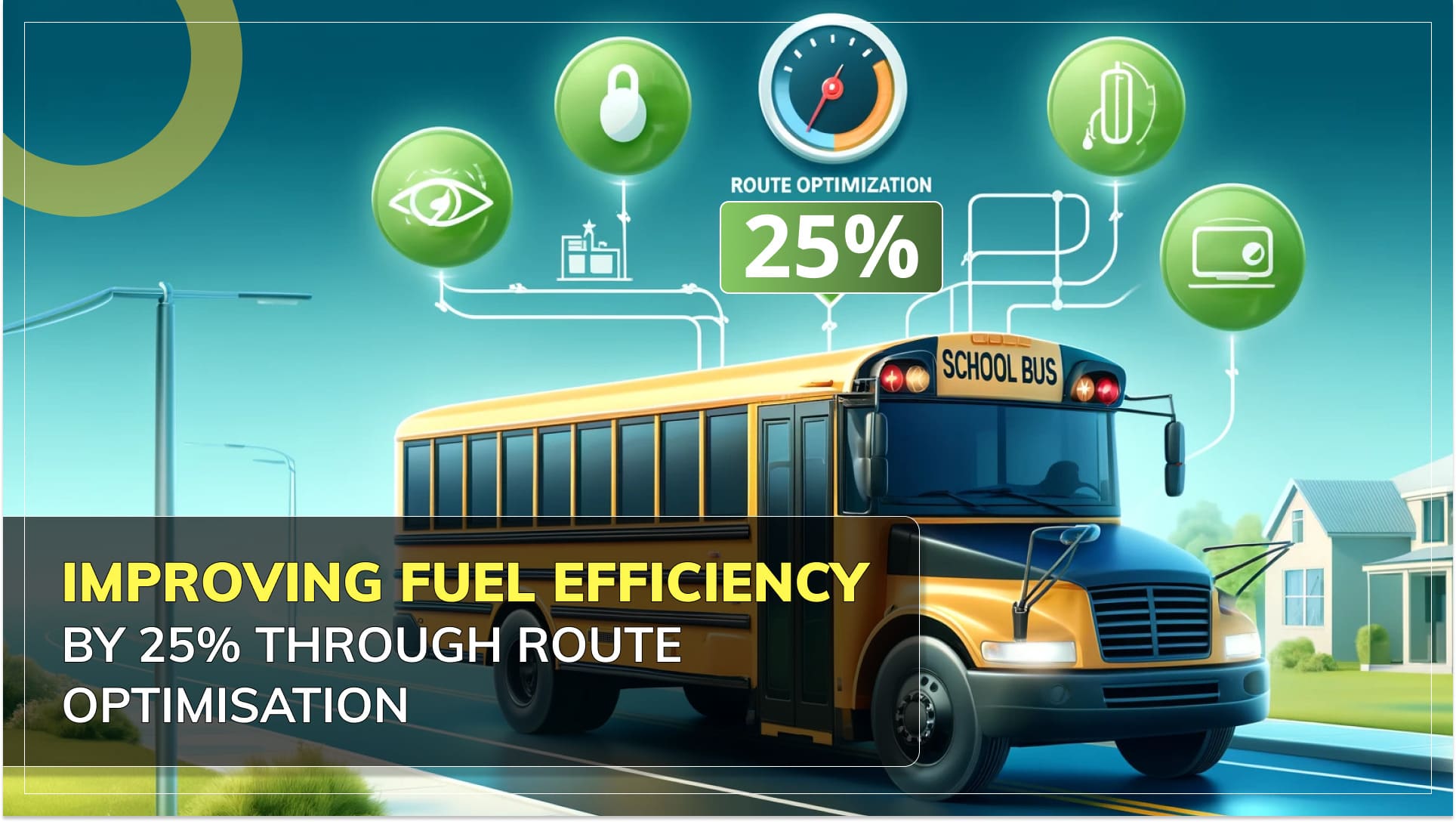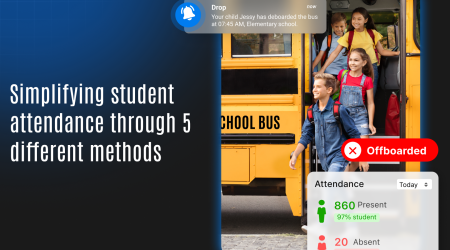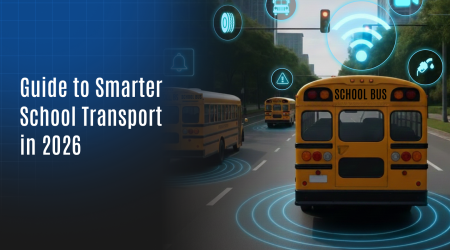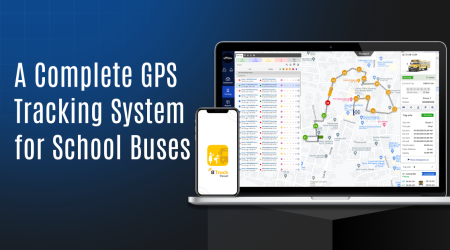Improve Fuel Efficiency by 25% in School Commute through Route Optimization

This is a story of a leading school bus service provider, who faced the common challenge of rising fuel costs. The company was keen to find a solution that would reduce expenses and enhance operational efficiency. After much research and evaluation, they decided to implement school bus tracking software to optimize their routes. This case study explores how they achieved a remarkable 25% improvement in fuel efficiency through strategic route optimization.
The Challenge: Rising Fuel Costs
School transportation services are essential but often face high operational costs, with fuel expenses being a significant part of the budget.. Managing a fleet of 150 school buses was no exception. The rising fuel prices and inefficient routes were eating into their profits. They needed a solution that would not only cut costs but also ensure timely and safe transportation for students.
The Solution: School Bus Tracking Software
To tackle the issue, they adopted advanced school bus tracking software. This software provided real-time data on bus locations, routes, and driving patterns. Utilizing this data allows the company to conduct thorough analysis and make strategic optimizations to their routes, enhancing overall efficiency. The primary focus was on minimizing travel distances, avoiding traffic congestion, and ensuring the shortest, safest routes for students.
Key Features of the Software:
- Real-Time Tracking: Monitors the exact location of each bus in real-time.
- Route Optimization: Suggests the most efficient routes based on traffic data and road conditions.
- Driver Behavior Monitoring: Tracks driving habits to promote fuel-efficient driving.
- Alerts and Notifications: Sends alerts for route deviations, delays, and maintenance needs.
- Parent and School Communication: Provides updates to parents and schools about bus arrivals and delays.
Implementation Process
The implementation of the school bus tracking software was a structured process involving several steps:
- Assessment and Planning: They conducted a thorough assessment of their current routes and fuel consumption patterns. They planned the integration of the software with minimal disruption to their operations.
- Software Integration: The tracking software was installed in all 150 buses. The installation process was quick, and the software started generating data immediately.
- Training: Drivers and dispatchers were trained to use the new system. They learned how to interpret the data, follow optimized routes, and adhere to fuel-efficient driving practices.
- Route Optimization: Using the data from the software, the company re-mapped all routes. They prioritized routes that minimized idle times, avoided traffic hotspots, and reduced the overall distance traveled.
- Monitoring and Adjustment: The routes were continuously monitored and adjusted based on real-time traffic updates and feedback from drivers.
Results: 25% Improvement in Fuel Efficiency
The results of implementing the school bus tracking software were impressive. They observed a 25% improvement in fuel efficiency within the first six months. Here’s how they achieved it:
Reduced Travel Distance
Optimizing routes is a direct method to cut down travel distances, which inherently lowers fuel consumption. The school bus tracking software employed sophisticated algorithms to analyze and suggest the most efficient routes based on real-time traffic data, historical route performance, and road conditions. This not only shortened the distance each bus travelled daily but also minimized the time spent on the road. Shorter routes mean buses burn less fuel, which translates directly into cost savings and less environmental impact.
Less Idle Time
Idle time refers to periods when buses run their engines while stationary, a common scenario at bus stops and during traffic jams. This non-productive use of fuel contributes significantly to increased fuel costs and unnecessary carbon emissions. With the implementation of optimized routing, buses experienced less congestion and fewer stop-start cycles. The software could suggest alternative routes during high traffic times or redirect buses to less congested stops, thus significantly reducing idle time. This active management of routes ensured that buses spent more time moving than idling, thereby conserving fuel.
Improved Driving Behavior
Driver behavior has a substantial impact on fuel efficiency. Practices such as harsh braking, rapid acceleration, and speeding can lead to excessive fuel consumption. The school bus tracking software included features to monitor these behaviors in real-time. It provided feedback not only to fleet managers but also directly to drivers, encouraging them to adopt smoother driving techniques. By promoting habits like gentle acceleration and deceleration, the software helped maintain consistent speeds and reduce unnecessary fuel burn. This not only improved fuel efficiency but also enhanced the safety of students on board.
Proactive Maintenance
Regular and timely maintenance of vehicles is crucial to keeping them running at optimal efficiency. A well-maintained bus consumes fuel more efficiently and is less likely to encounter mechanical issues that could lead to increased fuel consumption. The tracking software was equipped with alert systems that notified fleet managers of maintenance needs based on mileage, engine performance, or after a certain period. This proactive approach ensured that all parts of the bus, especially those critical for fuel efficiency like air filters, oil quality, and tire pressure, were kept in ideal condition. By maintaining buses in top shape, the system helped prevent scenarios where deteriorated parts might lead to increased fuel usage.
Together, these strategies formed a comprehensive approach to reducing fuel consumption. By addressing both the operational and behavioral aspects of bus management, the school bus tracking software enabled the fleet to operate more efficiently, safely, and economically.
Statistics:
- Fuel Savings: 25% reduction in fuel consumption, translating to substantial cost savings.
- Operational Efficiency: 15% decrease in average travel time per route.
- Environmental Impact: 20% reduction in carbon emissions due to lower fuel usage.
Benefits Beyond Fuel Efficiency
The advantages of route optimization go far beyond mere fuel savings, encompassing improved operational efficiency and enhanced service reliability. The school bus tracking software brought several additional advantages:
- Enhanced Safety: Real-time tracking and route optimization ensured that buses followed the safest possible routes. Parents and schools received timely updates, adding an extra layer of security for students.
- Improved Punctuality: With optimized routes, buses adhered to their schedules more accurately, reducing delays and ensuring students reached school and home on time.
- Better Resource Utilization: The data from the software helped in better fleet management, ensuring that all buses were utilized efficiently and reducing the need for additional vehicles.
- Increased Customer Satisfaction: Parents and schools appreciated the transparency and reliability brought by the tracking software, leading to higher satisfaction and trust in their services.
How to Implement Route Optimization in Your School Transportation Service
If you’re considering implementing route optimization in your school transportation service, here are some steps to get you started:
- Assess Your Current Operations: Understand your current routing and fuel consumption patterns. Identify problematic areas where improvements can be made.
- Choose the Right Software: Look for school bus tracking software that offers real-time tracking, route optimization, and driver behavior monitoring. Ensure it’s user-friendly and integrates well with your existing systems.
- Plan and Train: Develop a clear implementation plan and train your staff to use the new system effectively. Training should focus on both the technical aspects of the software and the importance of following optimized routes.
- Implement Gradually: Start with a pilot program, implementing the software in a few buses first. Monitor the results, make necessary adjustments, and then expand to the entire fleet.
- Monitor and Adjust: Continuously monitor the routes and driving behavior. Use the data to make ongoing adjustments and improvements.
Conclusion
Their experience demonstrates the significant impact that route optimization can have on fuel efficiency and overall operational performance. By leveraging advanced school bus tracking software, they achieved a remarkable 25% improvement in fuel efficiency, leading to substantial cost savings and enhanced service quality. If you manage a school transportation service, consider implementing route optimization to enjoy similar benefits. Start by assessing your current operations, choosing the right software, and training your staff. With careful planning and continuous monitoring, you can optimize your routes, reduce fuel consumption, and provide safer, more reliable transportation for students.


